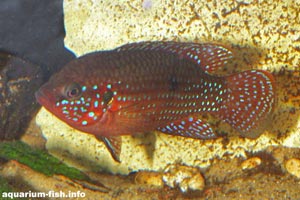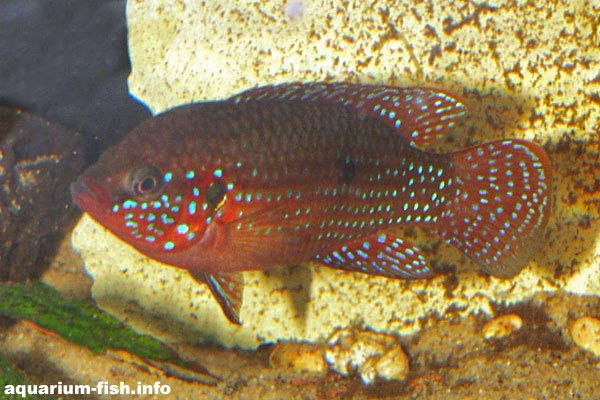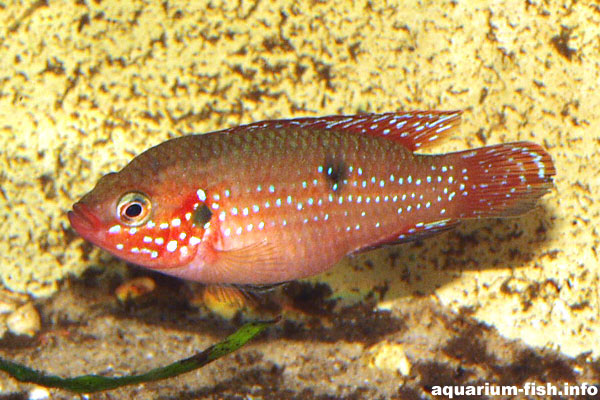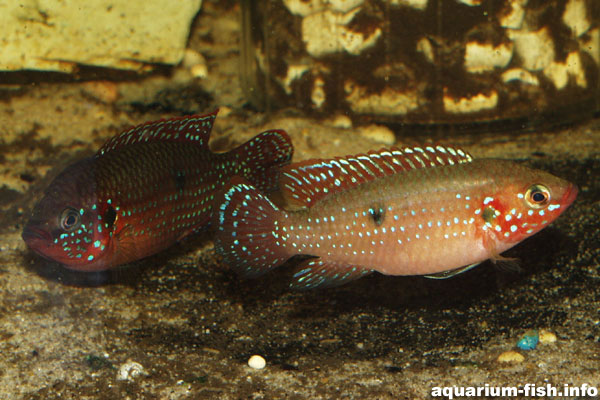

Species Profile | Images | Breeding Report | Similar Species

(Other members of the genus Hemichromis)
ADULT SIZE: 15 cm
WATER CONDITIONS: Not critical
TEMPERATURE RANGE: 21-24 C
FOOD: Feed Hemichromis bimaculatus small live-foods and fine grade dried foods
DISTRIBUTION: This species comes from Angola, Benin, Cameroon, Congo (DRC), Congo (Rep.), Equatorial Guinea, Gabon, Gambia, Ghana, Guinea, Guinea Bissau, Ivory Coast, Liberia, Mauritania, Nigeria, Senegal, Sierra Leone, Togo
AQUARIUM CARE: This is one of the most spectacular of all aquarium fishes; they truly are like jewels, with their sparkling, irredescent patterning over a rich red background. They are easy to keep, however should not be considered a community fish, as they can get quite aggressive at spawning time. They can be a little shy in many tanks. Provide adequte planting and caves. The Jewel cichlid inhabits a vast range in the wild - occuring in costal rivers in many West African countries. It likes somewhat cooler conditions than some cichlids.
BREEDING: Breeding is possible in the home aquarium. The fish will dig spawning pits in which to lay, and will tend eggs and fry.
Have you bred Hemichromis bimaculatus? Why not fill in a breeding questionaire?, or examine existing Hemichromis bimaculatus breeding reports
Other members of the genus Hemichromis
Other cichlid species
Other species from Angola, Benin, Cameroon, Congo (DRC), Congo (Rep.), Equatorial Guinea, Gabon, Gambia, Ghana, Guinea, Guinea Bissau, Ivory Coast, Liberia, Mauritania, Nigeria, Senegal, Sierra Leone, Togo

A colourful male

The female Jewel cichlid

A pair displaying to each other
BREEDING: Breeding is possible in the home aquarium. The fish will dig spawning pits in which to lay, and will tend eggs and fry.
Have you bred Hemichromis bimaculatus? Why not fill in a breeding questionaire?
This page summarises breeding reports provided by visitors to this site, along with some statistical analysis. Please feel free to contribute - whatever your experience!
| |||||||||
|
| ||||||||
|
| ||||||||
| |||||||||
|
| ||||||||
Remember, each record represents only one persons experience; if you had different results, or used different methods, please share your experiences
| Water conditions: Neutral | Water temperature: 20-23oC |
| Disposition: Somewhat aggresive on occasions | Community tank?: Only with species of similar size |
| Spawning Method: Long term (fry appear with adults) | Breeding problems: Poor fry survival rate |
| Sex ratio: | Breeding difficulty: Easy |
| Sucess: Fairly unsucessful | Years Experience: 1 |
| Other Comments: My jewel cichlid breeding was purely accidental. I did not realise that there were fry, and by the time I did, only one had survived. The pair spent most of their time behind a piece of slate leaning against the back wall - which, I presume, is where the eggs were laid. | |
| Date this record created: 6th January 2008 | Breeding date: 2007 |
| Breeder: | Location: |